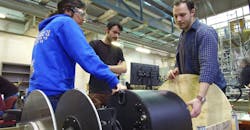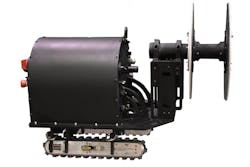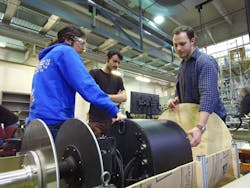Robots Aid in the Cleanup of Nuclear Facilities
Robots have been adapted to operate outside of industrial settings, exploring new applications as their capabilities have been perfected. Drones and humanoid robots are used for search and rescue purposes, and there are wheel-operated robots used in the disarming of bombs. Now researchers and engineers at Carnegie Mellon University have developed a robot to detect deposits of uranium, helping in the cleanup effort of nuclear waste sites.
RadPiper is a robot developed by the Carnegie Mellon University Robotics Institute for the Department of Energy. The robot is designed to move within the pipes of uranium-enrichment facilities to determine areas where radiation levels may pose a hazard. (Credit: Carnegie Mellon University)
Why Use Robots for Nuclear Waste?
The former uranium enrichment plant in Piketon, Ohio contains large amounts of uranium deposits on pipe walls. The plant began operations in 1954 and produced enriched uranium, including the weapons-grade variety. It was shut down in 2000. The size of the plant is 10.6 million sq. ft. of floor space, and it is the Department of Energy’s (DOE) largest uranium facility under roof. It contains three large three large buildings with enrichment process equipment that span the size of 158 football fields. The process buildings contain more than 75 miles of process pipe.
Before the DOE can begin decontamination, decommission, and demolish procedures, it is necessary to find the uranium deposits. Over the last three years, crews have manually performed more than 1.4 million measurements of process piping and components, and are close to declaring the building “cold and dark.” There are still 15 miles of piping to be characterized in the remaining process buildings.
The DOE estimates that by using the robots from CMU, it could perform the task more quickly and save tens of millions of dollars in completing the characterization of uranium deposits at the Portsmouth Gaseous Diffusion Plant in Piketon, as well as save perhaps $50 million at a similar uranium enrichment plant in Paducah, Ky.
How Robots Help the Cleanup Effort
The CMU has built two robots called RadPipers, which will be delivered to the DOE by May. These autonomous robots employ a new “disc-collimated” radiation sensor invented by the team at CMU. That team, led by William “Red” Whittaker, robotics professor and director of the Field Robotics Center, started the project in 2017. They worked closely with the DOE and Fluor-BWXT Portsmouth, the decommissioning contractor, to build a prototype quickly and test it at Portsmouth last fall.
The Robotics Institute at CMU and Whittaker have extensive experience with robots in nuclear facilities. They were involved in the design and construction of robots that aided with the cleanup of the damaged Three Mile Island reactor building in Pennsylvania and the crippled Chernobyl reactor in Ukraine.
Mechanical engineering Master's student Siri Maley, research associate Mohammad Mousaei, and mechanical engineering Master’s student Lawrence Papincak work a robot that will be used to identify uranium deposits on pipe walls. (Credit: Carnegie Mellon University)
The robot is tether-less, moving through the pipe at a steady pace atop a pair of flexible tracks. It is equipped with a LIDAR sensor and a fisheye camera to detect obstructions ahead, such as closed valves. After completing a run of pipe, the robot returns to its launch point. It provides the cleanup team with an integrated data analysis and report, available the same day. The robot’s “disc-collimated” sensing instrument uses a standard sodium iodide sensor to count gamma rays. The sensor is positioned between two large lead discs, which block gamma rays from uranium deposits that lie beyond the one-foot section of pipe that is being characterized.
The robot has proven to measure radiation levels more accurately from inside the pipe than is possible with external techniques. Besides labor costs, its use significantly reduces hazards to workers. Workers are at risk when they are required to use lifts and scaffolding to reach elevated pipes, requiring protective gear. The robot can access these hard-to-reach areas easily.
RadPiper will start by operating in pipes measuring 30 in. and 42 in. in diameter. It will characterize radiation levels in each foot-long segment of pipe. Those segments with potentially hazardous amounts of uranium-235, the fissile isotope of uranium used in nuclear reactors and weapons, will be removed and decontaminated. The majority of the plant’s piping will remain in place and will be demolished safely with the rest of the facility.
In addition to the Portsmouth and Paducah plants, robots could be useful at other nuclear sites, such as the Savannah River Site in Aiken, S.C., and the Hanford Site in Richland, Wash. According to Rodrigo V. Rimando, Jr., director of technology development for DOE’s Office of Environmental Management, “With at least 50 more years of nuclear cleanup to be performed, the [CMU] Robotics Institute could serve as a major pipeline of roboticists for DOE’s next several workforce generations.”



